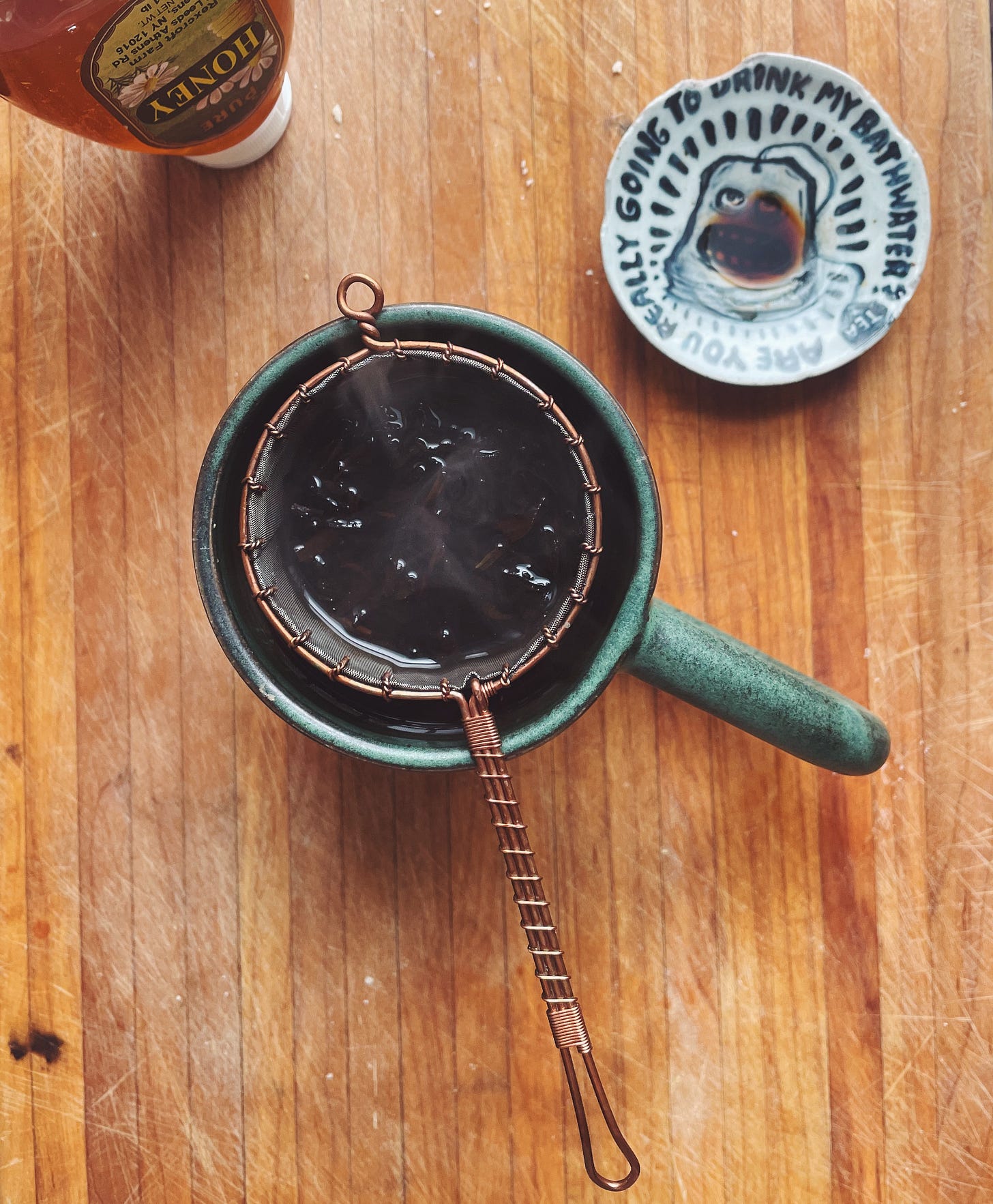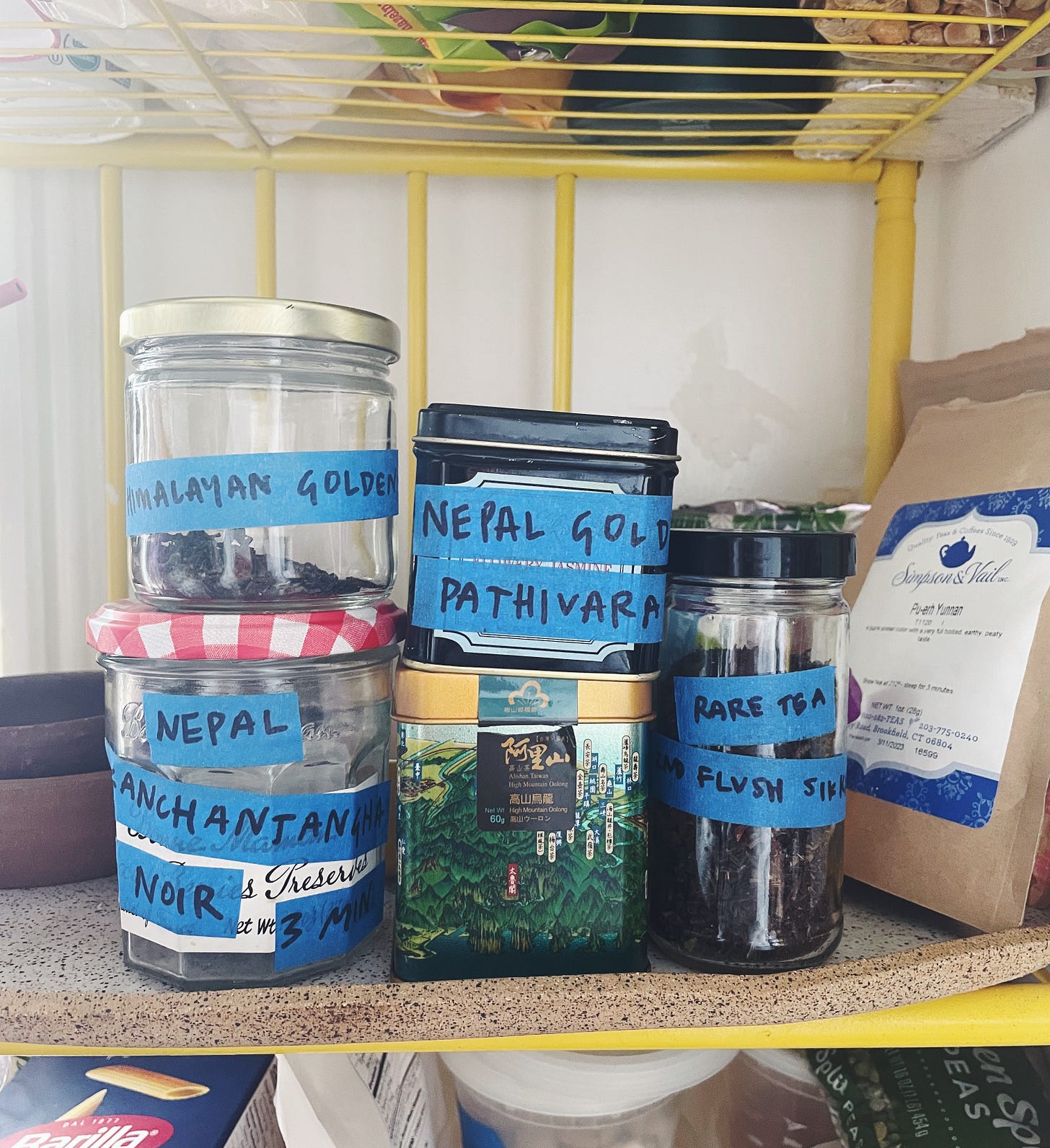the small and abundant luxury of tea
my new whole-leaf habit, my favorite teas, and a very elegant strainer
This post was supposed to go out last Friday but I had too much work last week, so you’re getting it on a Monday morning, which feels like a fitting time to receive a newsletter about the joys of DRINKING TEA!
Paid subscribers will have a fresh new (breakfast!!) recipe in their inbox this Friday. I’ve also started toying around with Subscriber chats—check that out on the Substack app or website if you feel like having a space where we can all chat about what we’re cooking.
Lastly…..Mess Hall has recently hit 4k subscribers! Thanks so much for being here, I am so grateful to have this space to write about food and cooking and all the things that surround them. :*
It is hilarious, now, to think of the outcry over Tamar Adler’s egg spoon. “Though I cringe to admit it,” the cookbook author wrote in a 2018 Grub Diet, “I not only own, but love, a hand-forged egg spoon.” She then went on to recount its use in the drafty, wood-heated carriage house where she writes: heat the spoon up on coals, add fat and herb and egg, return to coals until the egg is cooked. The egg spoon (sorry, Egg Spoon™), which today retails for $3101, was a wedding gift; before that, she used a campfire pie iron.
That a professional food writer and cook had a wrought-iron single-use instrument which offered a solution for cooking a beloved food in a fire-heated room made her, I guess, out of touch? Some low-grade backlash ensued, followed by a slew of defensive op-eds. The source of the outrage—past the obvious and exhausting dog-whistle misogyny—was in the foreign specificity of the egg spoon. Haters mistook it for a frivolous lark masquerading as hardy necessity, as if Adler was telling each reader that their kitchen wasn’t complete without one.
Similar outrage appeared a few years back when Mari Kondo began selling stuff. Here was this woman who had wanted us to get rid of our seventeen individual mismatched socks and five-dozen cookbook galleys we’d never touched, and now she wanted us to buy shit?? The collective huffing and puffing ignored her argument that what stuff peopled our lives should be stuff we look at and smile. I imagine that, for Adler, the egg spoon sparks joy. I imagine that, if I had a wood-heated carriage house in which I wrote the Next Great American Leftovers Cookbook, I would use one too.
I bring up the accursed egg spoon not to resuscitate a tiresome conversation about misogyny in food media and the classist tendencies of the slow food movement, but because it represents a category of small and specific luxury I have recently found myself thumbing like a precious stone. While I have been in a state of occasionally obsessive budgeting over the last six months, I have been simultaneously hoarding little luxuries. Small ones often carry more weight than big ones, it’s some sort of inverse logic. As evidence you might take a look at my tea shelf.
Around the time Adler wrote about her egg spoon, I was switching from coffee to tea. For the sake of my anxiety I downgraded my caffeine intake and immediately stopped feeling like I was going to have a level-nine panic attack every morning at 11 AM. Since then I’ve developed a habit of stockpiling whatever cheapo bagged tea I can find: at Wegmans you can get a hundred bags of ho-hum earl gray for ten dollars. Loaded with milk and honey, it does the trick of waking you up and tasting like tea, but if you shake a dry bag around in your hand, you’ll realize it’s full of not leaves, but dust. These are the dregs, and not particularly flavorful ones.
In February I interviewed R. for my book about the magic company I grew up in. She was the original company’s oldest child, and left just before I was born, so the experience was like meeting a long-lost cousin. Before we sat down for the interview she made me a cup of tea—loose leaf Darjeeling, steeped on the stove—far more elegant than the swill I’d been drinking at home. My response was so effusive that she very generously sent me a bag, and a thought occurred: what if I began drinking tea that actually tasted like something? What if I insisted on prioritizing pleasure during my first wakeful minutes instead of glugging down uppers just so I can begin my requisite hours of productivity as quickly as possible?
Before I could indulge in a shopping spree I’d convince myself was “practical”, my first order of business was to read a bunch of stuff Max Falkowitz has written on tea: introductory guides, advice on where to buy online, etc. I have since learned some basics of loose-leaf or whole-leaf tea, which is often of a higher quality and offers a richer flavor than the dusty stuff in the bag. Think of it as the difference between parmesan in a shaker jar and a craggy wedge of parmigiano wrested from a wheel. So explains Max:
The smaller a tea leaf's size, the faster it brews, but that brew will taste coarse, rough, and unbalanced compared to one made from larger tea leaves. […] A tea bag's chief benefits are speed and ease of use: it brews fast with no added equipment. But that's about it. Tiny tea dust particles tend to oversteep and turn bitter quickly, and the kinds of tea that find their way into teabags don't have much nuance to begin with.
(Buying whole-leaf tea also increases the likelihood that you’ll be buying from someone who purchases directly from farms, which means a more traceable provenance and a higher likelihood [though not always the assurance] that your money is going towards paying farmers fairly rather than, say, funneling into a company’s marketing and operations budget that would allow you to buy their tea at the mall. Or at least that is how I think of it.)

Obsessed with the Darjeeling that R. had served and sent me, I snooped around for Nepali tea (again, Max’s advice) and Darjeelings at Simpson & Vail (YUM, yum) and Nepali Tea Traders (oooooh), Rare Tea (YES!!!). I finally cracked open the tin of Oolong that Clio brought me from Taiwan, far too delicate and precious to drink with milk, but not too delicate to enjoy right now. The whole point of this category of pleasure is its immediacy, whereas hoarding the nice stuff always begs the question: what if I die tomorrow and never taste it? Wear the dress! Drink the tea! Open the overpriced tin of salmon! Life is for the living! I do think we have a moral imperative to squeeze out all the life and pleasure we can from this crumbling world while we’re on it.
As a food writer I’ve always been insecure about my palate. Coming into the food world a decade ago, I kept finding myself at third-wave coffee tastings; I never knew what to say past “this one’s fruity” or “this one’s dark?”. I’ve found the range of flavors in tea both wider and more accessible, more immediately exciting. A few of the Darjeelings I’ve tried have an alluring trace of rose, which shocks me because I generally hate floral flavors but love this. And you can still taste most of that nuance under the cozy blanket of milk and honey that I prefer. Since you can buy samples of lots of loose-leaf teas, it’s easy and not particularly indulgent to have six types of tea in rotation. Each day, then, is a new treat, a new adventure. I choose a tea like you might choose an outfit. It is a salve against mundanity, wrapped up in the comfort of ritual.
Soon I began dreaming of an upgraded tea strainer, and after a luxurious afternoon of online browsing I found a copper strainer, handmade in Japan, the Etsy page even included hi-res photos of an old man making one, you know I’m a sucker for that shit. (It’s currently out of stock, but the company has a few other versions.) I even went so far as to spring for an expensive and tiny gaiwan, which I admit I have not used yet. But the strainer and all my teas, which sometimes taste of roses or grapes or earth or rain or peat, have intensified the pleasure I experience each morning when I drink them, rich with local honey and whole milk2. I have an extensive mug collection but only drink out of maybe three of them: one that I made, one from Ginny Sims, one that my parents received as a wedding gift. It’s easy to think of luxury as a synonym for priciness but in fact I find it’s closer to pleasure: a luxury for me is something that affords joy or ease or excitement, with little effort, and little remorse.
Anyways I like that when I dump my twice-steeped3 nest of wet leaves into my compost jar, it looks like plants—not because I think this is the morally superior choice, but because plants look cool. The damp leaves, brown and green and wriggly, bend around each other and nestle together and I spend two and a half seconds tracing their shapes until I am once again distracted. The strainer lives on a little ceramic dish from Dave Zackin painted with a bedraggled teabag that reads ARE YOU REALLY GOING TO DRINK MY BATHWATER? These are the small things that bring me joy right now, a kind of joy that is all my own, small and intense, and awaiting me each day.
Here are some teas I like:
Keep reading with a 7-day free trial
Subscribe to Mess Hall to keep reading this post and get 7 days of free access to the full post archives.





